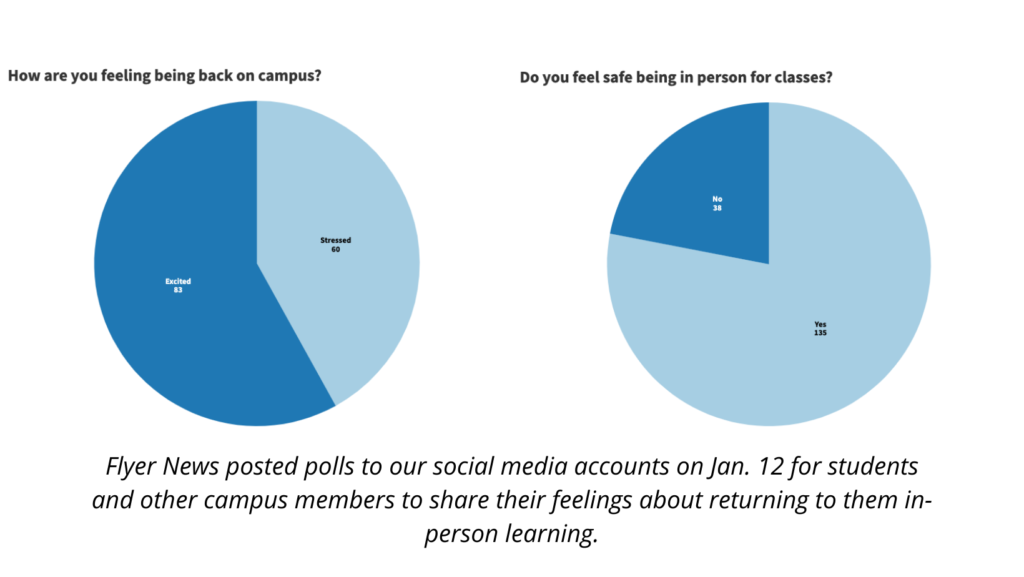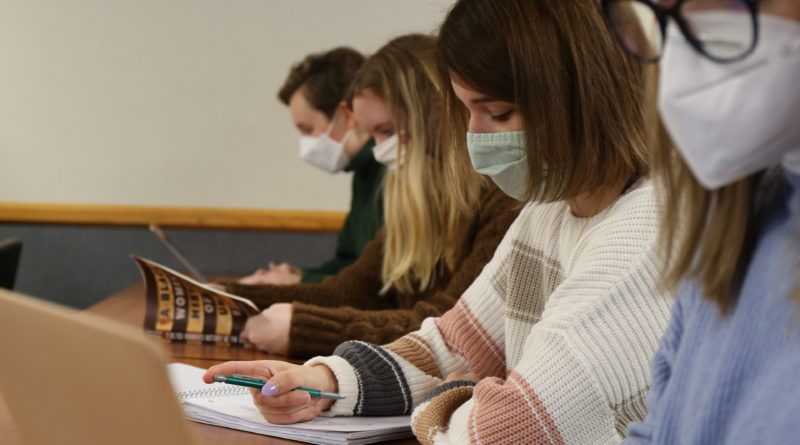Faculty share mixed emotions returning to in-person instruction during COVID-19 spike
Like last semester, the UD campus community is required to mask indoors, social distance when possible and get tested for COVID-19 if symptoms occur. Photo courtesy of Keegan Gupta, Flyer News.

Kaitlin Lewis | Online Editor-in-Chief
On Jan. 10, the University of Dayton started in-person instruction for the spring semester.
The plans to return to campus didn’t differ much from last semester: mask up indoors, keep distancing and get tested when symptoms of COVID-19 arise. Quarantine and isolation practices were still in place and positive cases were to be reported to the university.
In addition, UD continues to encourage, but not require, the campus community to get vaccinated against the virus.
What differed from the fall, however, was the continuing spike in COVID-19 cases due to the most contagious variant of the virus yet. In the week leading up to classes, Montgomery County was the fifth-highest county in Ohio in terms of COVID-19 cases, and was the second highest for hospitalizations from the virus.
With the uncertainty of how the Omicron variant might spread on campus, faculty, staff and students all shared different opinions about returning for the spring semester. The UD Path Forward team told Flyer News that they have received both positive and negative feedback about how the university has chosen to handle the pandemic.
One significant opinion, the team said, was that students shared incredible amounts of positive feedback about the importance of in-person learning. When the Path Forward team announced plans for the spring semester on Jan. 4, one of the driving forces for continuing in-person instruction was the “significant, long-term academic and life challenges” that come with remote learning.
However, some faculty members have shared that they had mixed emotions before returning to the classroom this spring.
Hesitancy around the unknowns of Omicron
Dr. Jason Combs, coordinator of the Dialogue Zone and professor in the communication department at UD, said that he had some hesitancy due to the uncertainty of the Omicron variant.
“I wasn’t against it by any means, because I think face-to-face learning is better for everybody overall,” Combs told Flyer News.
“My whole family had COVID back in January of last year, and we had a pretty serious bout with it – I was really sick,” Combs added. “So, it was something I didn’t want to repeat.”

Dr. Chelse Prather, professor of biology at UD, expressed a similar concern to Combs, reiterating that while she was excited to hold classes in-person, there is a lot of uncertainty around the spike of COVID-19 cases.
“I understand the university’s decision and all of my students have been very responsible about masking in class, but I would have preferred to hold classes remotely until after this wave of the virus peaked to keep those that are vulnerable in our community safe,” Prather said.
Prather added that for faculty members with young children in school, online instruction would have helped while navigating school closures, quarantining practices and illness.
“My son actually contracted the virus this past week from school, and I was also infected,” Prather told Flyer News Friday. “I had to make my classes remote this past week while I was isolated at home. Luckily, my family’s symptoms were relatively mild, and now that we are all familiar with these online technologies, I was able to pivot the class quickly to be online and keep the class moving along.”
Other faculty members who are also parents shared that their family plays a huge role in their anxieties about returning to in-person classes, such as Dr. Joel Pruce, professor in the political science department and father of two.
“I have two children; one is too young to be vaccinated and the other has a health condition,” Pruce said. “So everytime I’m in the classroom when rates are presumably as high as they are, I risk the health of my children.”
Similar to Prather as well, Pruce said he had to utilize online instruction tools, such as a hybrid-classroom format, during the first week of classes due to several students being exposed, symptomatic or positive for COVID-19.
Both Pruce and Prather said that one way they believe the campus community could be safer against the virus is by mandating vaccines for all students, faculty and staff members.
“Other universities have upwards of 90 to 95 percent vaccination rates,” Pruce said. “What that means is the virus will spread less freely, which will mean fewer people will get sick, which means more continuity in class and general functions as well as much less impact on the community health resources that are already stretched thin.”
The Ohio State University requires all staff, faculty and students to receive a COVID-19 vaccine or an exemption. In December, OSU reported that the university had a vaccination rate of 92%. The University of Cincinnati also requires vaccines for their campus, but information regarding vaccination rates is not available online.
University reaction to mixed emotions among faculty
To address concerns about returning to in-person learning, the university hosted a town hall for faculty and staff on Jan. 7, three days before classes began. The Path Forward team told Flyer News that due to concerns brought up during the meeting, the team made updates to their protocols before classes began, such as now requiring masks in all public areas of residences halls.
“As we have said throughout the pandemic, the university’s protocols and requirements are subject to change depending on conditions on campus and in the community, and on CDC and government guidance and requirements,” the Path Forward team told Flyer News. “We should add to that ‘based on community feedback,’ because we do take our community’s concerns into account.”
Pruce said that no further public meeting including the Path Forward team and faculty members has been held since the town hall.
Talking about COVID-19 among differing opinions
Combs said that in response to the outbreak of the virus in spring of 2020, the Dialogue Zone had hosted a couple of dialogues to create space that allowed campus members to process together and voice any concerns or fears about the pandemic.
He added that when creating spaces for topics such as COVID-19 where there can be a large distribution of opinions, it’s important that speakers hold to the basics of communicating so that all voices can be heard.
“Some of the things we [the Dialogue Zone] preach and try to practice is that dialogue is aimed at mutual understanding,” Combs said. “There’s not a pressure that we agree – if we agree that’s great, but we don’t expect in a dialogue that we will agree with each other, it’s just something that kind of happens or it doesn’t.”
Combs said that throughout UD’s plans to continue instruction despite the pandemic, some voices and concerns about the university’s policies have probably not been heard as well as they could be.
“I think there’s always a risk when there’s a desire to get back to normal for people who have concerns that are more marginalized or more in the minority to just be kind of left aside,” Combs said. “I think that’s probably happened in this case. I don’t think it’s necessarily the fault of anybody but I think we always have to be really careful when there’s a push to make sure that those voices are heard.”
Prather added that it’s important to stay flexible and help one another while navigating the pandemic.
“Anxiety among students, faculty, and staff is still running very high as we deal with uncertainty due to this virus,” Prather said. “I hope that we can all continue to be flexible with one another to meet the demands of this very challenging time.”
For more campus news like Flyer News on Facebook and follow us on Twitter (@FlyerNews) and Instagram (@flyernews).

